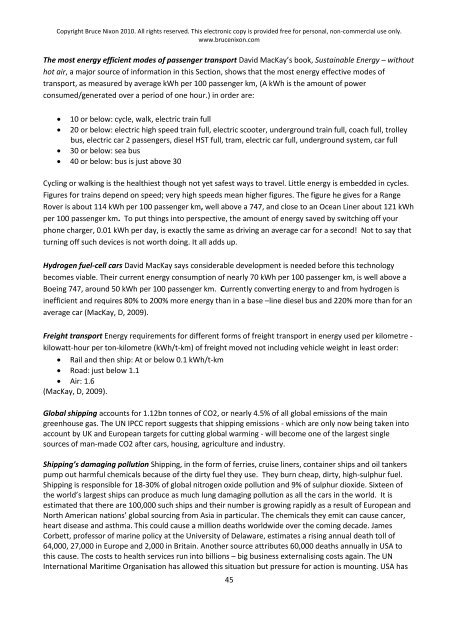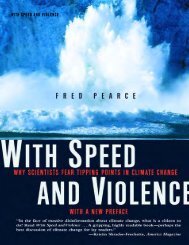A better world is possible - Global Commons Institute
A better world is possible - Global Commons Institute
A better world is possible - Global Commons Institute
You also want an ePaper? Increase the reach of your titles
YUMPU automatically turns print PDFs into web optimized ePapers that Google loves.
Copyright Bruce Nixon 2010. All rights reserved. Th<strong>is</strong> electronic copy <strong>is</strong> provided free for personal, non-commercial use only.<br />
www.brucenixon.com<br />
The most energy efficient modes of passenger transport David MacKay’s book, Sustainable Energy – without<br />
hot air, a major source of information in th<strong>is</strong> Section, shows that the most energy effective modes of<br />
transport, as measured by average kWh per 100 passenger km, (A kWh <strong>is</strong> the amount of power<br />
consumed/generated over a period of one hour.) in order are:<br />
10 or below: cycle, walk, electric train full<br />
20 or below: electric high speed train full, electric scooter, underground train full, coach full, trolley<br />
bus, electric car 2 passengers, diesel HST full, tram, electric car full, underground system, car full<br />
30 or below: sea bus<br />
40 or below: bus <strong>is</strong> just above 30<br />
Cycling or walking <strong>is</strong> the healthiest though not yet safest ways to travel. Little energy <strong>is</strong> embedded in cycles.<br />
Figures for trains depend on speed; very high speeds mean higher figures. The figure he gives for a Range<br />
Rover <strong>is</strong> about 114 kWh per 100 passenger km, well above a 747, and close to an Ocean Liner about 121 kWh<br />
per 100 passenger km. To put things into perspective, the amount of energy saved by switching off your<br />
phone charger, 0.01 kWh per day, <strong>is</strong> exactly the same as driving an average car for a second! Not to say that<br />
turning off such devices <strong>is</strong> not worth doing. It all adds up.<br />
Hydrogen fuel-cell cars David MacKay says considerable development <strong>is</strong> needed before th<strong>is</strong> technology<br />
becomes viable. Their current energy consumption of nearly 70 kWh per 100 passenger km, <strong>is</strong> well above a<br />
Boeing 747, around 50 kWh per 100 passenger km. Currently converting energy to and from hydrogen <strong>is</strong><br />
inefficient and requires 80% to 200% more energy than in a base –line diesel bus and 220% more than for an<br />
average car (MacKay, D, 2009).<br />
Freight transport Energy requirements for different forms of freight transport in energy used per kilometre -<br />
kilowatt-hour per ton-kilometre (kWh/t-km) of freight moved not including vehicle weight in least order:<br />
Rail and then ship: At or below 0.1 kWh/t-km<br />
Road: just below 1.1<br />
Air: 1.6<br />
(MacKay, D, 2009).<br />
<strong>Global</strong> shipping accounts for 1.12bn tonnes of CO2, or nearly 4.5% of all global em<strong>is</strong>sions of the main<br />
greenhouse gas. The UN IPCC report suggests that shipping em<strong>is</strong>sions - which are only now being taken into<br />
account by UK and European targets for cutting global warming - will become one of the largest single<br />
sources of man-made CO2 after cars, housing, agriculture and industry.<br />
Shipping’s damaging pollution Shipping, in the form of ferries, cru<strong>is</strong>e liners, container ships and oil tankers<br />
pump out harmful chemicals because of the dirty fuel they use. They burn cheap, dirty, high-sulphur fuel.<br />
Shipping <strong>is</strong> responsible for 18-30% of global nitrogen oxide pollution and 9% of sulphur dioxide. Sixteen of<br />
the <strong>world</strong>’s largest ships can produce as much lung damaging pollution as all the cars in the <strong>world</strong>. It <strong>is</strong><br />
estimated that there are 100,000 such ships and their number <strong>is</strong> growing rapidly as a result of European and<br />
North American nations’ global sourcing from Asia in particular. The chemicals they emit can cause cancer,<br />
heart d<strong>is</strong>ease and asthma. Th<strong>is</strong> could cause a million deaths <strong>world</strong>wide over the coming decade. James<br />
Corbett, professor of marine policy at the University of Delaware, estimates a r<strong>is</strong>ing annual death toll of<br />
64,000, 27,000 in Europe and 2,000 in Britain. Another source attributes 60,000 deaths annually in USA to<br />
th<strong>is</strong> cause. The costs to health services run into billions – big business external<strong>is</strong>ing costs again. The UN<br />
International Maritime Organ<strong>is</strong>ation has allowed th<strong>is</strong> situation but pressure for action <strong>is</strong> mounting. USA has<br />
45
















